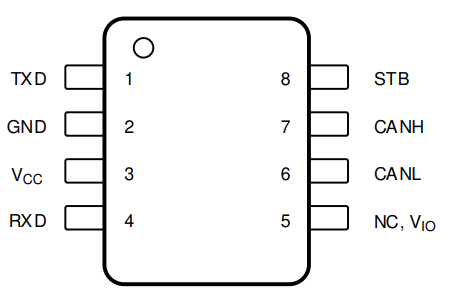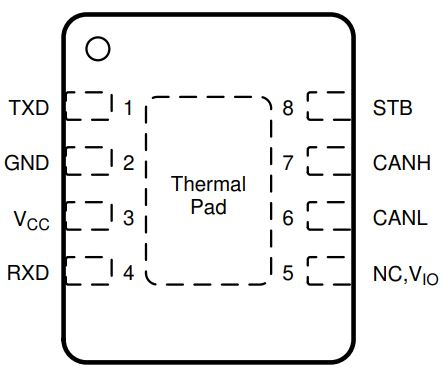This section provides a Failure Mode Analysis
(FMA) for the pins of the TCAN1044A-Q1, TCAN1044AV-Q1, and TCAN1044AEV-Q1. The
failure modes covered in this document include the typical pin-by-pin failure
scenarios:
Table 4-2 through Table 4-7 also indicate how these pin conditions can affect the device as
per the failure effects classification in Table 4-1.
Table 4-1 TI Classification of Failure
Effects| Class | Failure Effects |
|---|
| A | Potential device damage that affects
functionality |
| B | No device damage, but loss of functionality |
| C | No device damage, but performance degradation |
| D | No device damage, no impact to functionality or
performance |
#GUID-59B67224-3CC4-4810-AE39-411866CAB6F7 shows the TCAN1044A-Q1/TCAN1044AV-Q1/TCAN1044AEV-Q1 SOIC pin diagram. #FIG_VVB_MNB_PMB shows the TCAN1044A-Q1/TCAN1044AV-Q1 VSON pin diagram. #FIG_T3Q_NNB_PMB shows the TCAN1044A-Q1/TCAN1044AV-Q1/TCAN1044AEV-Q1 SOT pin diagram. For a
detailed description of the device pins please refer to the Pin Configuration and
Functions section in the TCAN1044A-Q1/TCAN1044AV-Q1 and TCAN1044AEV-Q1 data
sheets.
 Figure 4-1 SOIC Pin Diagram
Figure 4-1 SOIC Pin Diagram Figure 4-3 SOT Pin Diagram
Figure 4-3 SOT Pin Diagram Figure 4-2 VSON Pin Diagram
Figure 4-2 VSON Pin DiagramFollowing are the assumptions of use
and the device configuration assumed for the pin FMA in this section:
- VCC = 4.5 to 5.5 V
- VBAT = 6 to 24 V
- VIO = 1.7 to 5.5 V
Table 4-2 Pin FMA for Device Pins
Short-Circuited to Ground| Pin Name | Pin No. | Description of Potential Failure Effect(s) | Failure Effect Class |
|---|
| TXD | 1 | Device will enter dominant time out
mode. Unable to transmit data. | B |
| GND | 2 | None | D |
| VCC | 3 | Device unpowered, high ICC
current. | B |
| RXD | 4 | RXD default is high side FET ON, with pin short to ground, it forms
direct path between supply and ground causing high current | A |
| NC | 5 | None | D |
| VIO | 5 | Device will be in protected mode.
Transceiver passive on bus. | B |
| CANL | 6 | VO(REC) spec violated.
Degraded EMC performance. | C |
| CANH | 7 | Device cannot drive dominant to the bus,
no communication possible. | B |
| STB | 8 | STB stuck low, transceiver unable to
enter low-power mode. | B |
| Thermal Pad | - | None | D |
Note: The VSON package includes a thermal pad.
Table 4-3 Pin FMA for Device Pins
Open-Circuited
| Pin Name |
Pin No. |
Description of Potential Failure Effect(s) |
Failure Effect Class |
| TXD |
1 |
TXD pin defaults high, device always
recessive and unable to transmit data. |
B |
| GND |
2 |
Device unpowered. |
B |
| VCC |
3 |
Device unpowered. |
B |
| RXD |
4 |
No RXD output, unable to receive
data. |
B |
| NC |
5 |
None |
D |
| VIO |
5 |
Device will be in protected mode.
Transceiver passive on bus. |
B |
| CANL |
6 |
Device cannot drive dominant on the bus,
unable to communicate. |
B |
| CANH |
7 |
Device cannot drive dominant on the bus,
unable to communicate. |
B |
| STB |
8 |
STB pin defaults high, transceiver stuck
in low-power mode. |
B |
| Thermal Pad |
- |
None |
D |
Note: The VSON package includes a thermal pad.
Table 4-4 Pin FMA for Device Pins
Short-Circuited to Adjacent Pin| Pin Name | Pin No. | Shorted to | Description of Potential Failure Effect(s) | Failure Effect Class |
|---|
| TXD | 1 | GND | Device will enter dominant time out
mode. Unable to transmit data. | B |
| GND | 2 | VCC | Device unpowered, high
ICCcurrent. | B |
| VCC | 3 | RXD | RXD output stuck high, unable to receive
data. | B |
| NC | 5 | CANL | None | D |
| VIO | 5 | CANL | Bus stuck recessive, no communication
possible. IOS current may be reached on CANL. | B |
| CANL | 6 | CANH | Bus stuck recessive, no communication
possible. IOS current may be reached on
CANH/CANL. | B |
| CANH | 7 | STB | Driver and receiver turn off when a
dominant is driven. May not enter normal mode. | B |
Note: The VSON package includes a thermal
pad. All device pins are adjacent to the thermal pad. The device behavior when pins
are shorted to the thermal pad depends on which net is connected to the thermal
pad.
Table 4-5 Pin FMA for Device Pins Short-Circuited to
VCC| Pin Name | Pin No. | Description of Potential Failure Effect(s) | Failure Effect Class |
|---|
| TXD | 1 | TXD stuck high, unable to transmit
data. | B |
| GND | 2 | Device unpowered, high ICC
current. | B |
| VCC | 3 | None | D |
| RXD | 4 | RXD pin stuck high, unable to receive
data. | B |
| NC | 5 | None | D |
| VIO | 5 | IO pins will operate as 5V input/outputs. Microcontroller may be
damaged if VCC > VIO. | C |
| CANL | 6 | RXD always recessive, no communication
possible. IOS current may be reached. | B |
| CANH | 7 | VO(REC) spec violated,
degraded EMC performance. | C |
| STB | 8 | STB stuck high, transceiver always in
standby mode. | B |
Table 4-6 Pin FMA for Device Pins Short-Circuited to VBAT| Pin Name | Pin No. | Description of Potential Failure Effect(s) | Failure Effect Class |
|---|
| TXD | 1 | Absolute maximum violation, transceiver
may be damaged. Unable to transmit data. | A |
| GND | 2 | Device unpowered, high IBAT
current | B |
| VCC | 3 | Absolute maximum violation, transceiver
may be damaged. Bus may be unable to communicate. | A |
| RXD | 4 | Absolute maximum violation, transceiver
may be damaged. Unable to receive data. | A |
| NC | 5 | None | D |
| VIO | 5 | Absolute maximum violation, transceiver
may be damaged. | A |
| CANL | 6 | RXD always recessive, no communication
possible. IOS current may be reached. | B |
| CANH | 7 | VO(REC) spec violated,
degraded EMC performance. | C |
| STB | 8 | Absolute maximum violation, transceiver
may be damaged. Transceiver stuck in low-power mode. | A |
Table 4-7 Pin FMA for Device Pins Short-Circuited to
VIO| Pin Name | Pin No. | Description of Potential Failure Effect(s) | Failure Effect Class |
|---|
| TXD | 1 | TXD stuck high, unable to transmit
data. | B |
| GND | 2 | Device unpowered, high IIO
current. | B |
| VCC | 3 | IO pins will operate as 5V input/outputs. Microcontroller may be
damaged if VCC > VIO. | C |
| RXD | 4 | RXD pin stuck high, unable to receive
data. | B |
| NC | 5 | None | D |
| VIO | 5 | None | D |
| CANL | 6 | RXD always recessive, no communication possible. IOS
current may be reached is VIO ≥ 3.3V. | B |
| CANH | 7 | VO(REC) spec violated if VIO ≥ 3.3V, degraded
EMC performance. | C |
| STB | 8 | STB stuck high, transceiver always in
standby mode. | B |
Note: Table 4-7 is only applicable to the TCAN1044AV-Q1/TCAN1044AEV-Q1 device.
 Figure 4-1 SOIC Pin Diagram
Figure 4-1 SOIC Pin Diagram Figure 4-3 SOT Pin Diagram
Figure 4-3 SOT Pin Diagram Figure 4-2 VSON Pin Diagram
Figure 4-2 VSON Pin Diagram